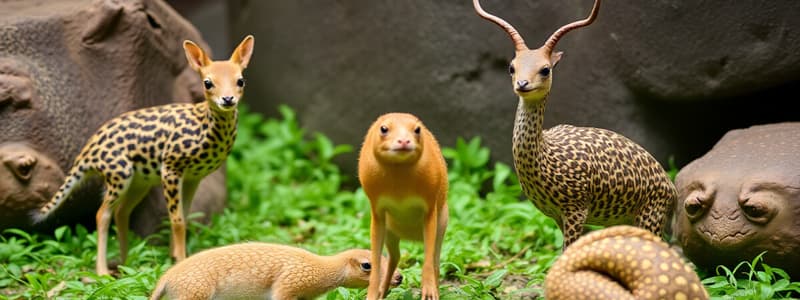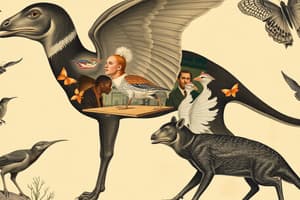Podcast
Questions and Answers
पारिस्थितिकी तंत्र में जैव विविधता को प्रभावित करने वाले प्रमुख खतरों में कौन सा शामिल नहीं है?
पारिस्थितिकी तंत्र में जैव विविधता को प्रभावित करने वाले प्रमुख खतरों में कौन सा शामिल नहीं है?
- जलवायु परिवर्तन
- आवास का नुकसान
- शिकार
- परंपरागत कृषि (correct)
विकासात्मक इतिहास को समझने के लिए महत्वपूर्ण स्रोत क्या हैं?
विकासात्मक इतिहास को समझने के लिए महत्वपूर्ण स्रोत क्या हैं?
- स्लैंग भाषा
- सामाजिक विज्ञान
- तुलनात्मक शारीरिक संरचना (correct)
- सांस्कृतिक अध्ययन
कौन सा तत्व विकासात्मक संबंधों का अध्ययन करने में योगदान नहीं देता?
कौन सा तत्व विकासात्मक संबंधों का अध्ययन करने में योगदान नहीं देता?
- अनुवांशिकी प्रवाह
- सर्पिल कुएं (correct)
- प्राकृतिक चयन
- अनुवांशिक परिवर्तन
सहेजने की रणनीतियों में निम्नलिखित में से कौन शामिल नहीं है?
सहेजने की रणनीतियों में निम्नलिखित में से कौन शामिल नहीं है?
उन्नत जैव विविधता की जड़ को समझने के लिए कौन सा तत्त्व सबसे महत्वपूर्ण है?
उन्नत जैव विविधता की जड़ को समझने के लिए कौन सा तत्त्व सबसे महत्वपूर्ण है?
जानवरों का अध्ययन किस शाखा में किया जाता है?
जानवरों का अध्ययन किस शाखा में किया जाता है?
जानवरों को किस आधार पर श्रेणियों में वर्गीकृत किया जाता है?
जानवरों को किस आधार पर श्रेणियों में वर्गीकृत किया जाता है?
जानवरों के भिन्न-भिन्न पर्यावरण में सर्वाइवल के लिए कौन सी विशेषताएँ विकसित होती हैं?
जानवरों के भिन्न-भिन्न पर्यावरण में सर्वाइवल के लिए कौन सी विशेषताएँ विकसित होती हैं?
जानवरों के व्यवहार का अध्ययन किस पहलू को ध्यान में रखता है?
जानवरों के व्यवहार का अध्ययन किस पहलू को ध्यान में रखता है?
पारिस्थितिकी का अध्ययन किससे संबंधित है?
पारिस्थितिकी का अध्ययन किससे संबंधित है?
कौन सी विशेषता जानवरों की प्रस्तुति में विविधता को दर्शाती है?
कौन सी विशेषता जानवरों की प्रस्तुति में विविधता को दर्शाती है?
जानवरों के विकास का अध्ययन क्या बताता है?
जानवरों के विकास का अध्ययन क्या बताता है?
जीवविज्ञान में जानवरों के अंग प्रणाली का अध्ययन किसे शामिल करता है?
जीवविज्ञान में जानवरों के अंग प्रणाली का अध्ययन किसे शामिल करता है?
Flashcards
Evolutionary mechanisms
Evolutionary mechanisms
Processes like natural selection, mutation, and genetic drift that drive changes in species over time, leading to adaptation.
Animal conservation
Animal conservation
Protecting and managing animal populations and their habitats from threats, such as habitat loss and poaching.
Comparative anatomy
Comparative anatomy
Study of similarities and differences in body structures of different species, helping to understand evolutionary relationships.
Biodiversity
Biodiversity
Signup and view all the flashcards
Evolutionary relationships
Evolutionary relationships
Signup and view all the flashcards
Zoology definition
Zoology definition
Signup and view all the flashcards
Animal Classification
Animal Classification
Signup and view all the flashcards
Animal Diversity
Animal Diversity
Signup and view all the flashcards
Animal Anatomy/Physiology
Animal Anatomy/Physiology
Signup and view all the flashcards
Animal Behavior
Animal Behavior
Signup and view all the flashcards
Animal Ecology
Animal Ecology
Signup and view all the flashcards
Animal Evolution
Animal Evolution
Signup and view all the flashcards
Taxonomic Groups
Taxonomic Groups
Signup and view all the flashcards
Study Notes
Introduction to Zoology
- Zoology is the branch of biology that studies animals.
- It encompasses a vast array of topics, including animal behavior, physiology, evolution, and ecology.
- Zoologists use diverse methods, including observation, experimentation, and modeling, to understand animal life.
- The field is interdisciplinary, drawing on knowledge from various other scientific disciplines.
Animal Classification
- Animals are categorized into groups based on shared characteristics and evolutionary relationships.
- The most commonly used system is based on a hierarchy of taxa, from kingdom to species.
- Key taxonomic groups include invertebrates (e.g., insects, mollusks) and vertebrates (e.g., mammals, birds).
- Classification systems are constantly being refined as new data emerges through research.
Animal Diversity
- The animal kingdom exhibits incredible diversity in form, function, and behavior.
- This encompasses a huge range of species adaptations to various environments.
- Examples include terrestrial, aquatic, and aerial lifestyles, diverse feeding strategies, and unique reproductive mechanisms, as well as evolutionary histories leading to the observed diversity.
Animal Anatomy and Physiology
- This involves studying the internal and external structure and function of animals.
- It examines organ systems, tissues, cells, and their interactions within animals.
- Different animals have adapted structures and functions ideal for survival in various environments.
- Exemplar topics include digestion, respiration, circulation, and the nervous system.
Animal Behavior
- This subfield investigates how animals interact with their environment and each other.
- Topics include communication, foraging, mating rituals, and social interactions among different species.
- Factors that drive behavior can be innate (instinctive) or learned through experience.
- Animal behaviors are often influenced by ecological pressures, as well as genetic predispositions.
Animal Ecology
- This is the study of the relationships between animals and their environment.
- It includes the study of interactions within habitats, food webs, animal populations, and the impacts of environmental change on animals.
- Competition, predation, and symbiosis are core concepts in this realm of study.
- Research in this area often focuses on conservation efforts.
Animal Evolution
- Study of how animal lineages have evolved over millions of years.
- This includes tracing ancestral relationships and understanding evolutionary mechanisms like natural selection, mutation, and genetic drift that contribute to the diversity of adaptations in animals.
- Comparative anatomy, molecular biology, and fossil records are important sources of information for understanding evolutionary history.
- Analyzing evolutionary relationships helps understand the origins of diverse animal lineages.
Animal Conservation
- This involves protecting and managing animal populations and their habitats.
- It deals with threats such as habitat loss, poaching, and climate change that negatively impact biodiversity.
- Conservation strategies include habitat restoration, anti-poaching efforts, and promoting sustainable practices.
- There is an increasing focus on understanding and mitigating the impact of human activities on wildlife populations.
Studying That Suits You
Use AI to generate personalized quizzes and flashcards to suit your learning preferences.




